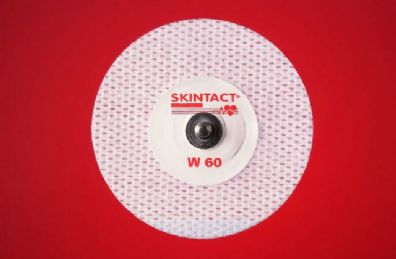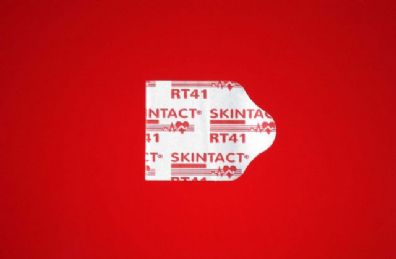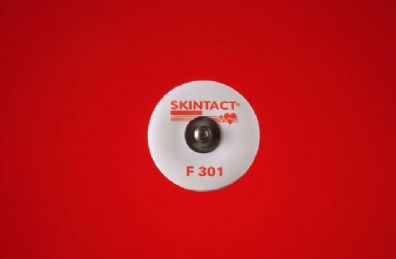
.png&newheight=260&quality=80)




.jpg&newheight=260&quality=80)










.png&newheight=260&quality=80)



What is an ECG Electrode?
An electrocardiogram (ECG or EKG) is a medical test used to evaluate and diagnose possible heart problems. An ECG electrode is a device attached to the skin on certain parts of a person’s body, usually the chest, arms, and legs, during an ECG procedure. It detects electrical impulses that are produced every time the heart beats. The placement and number of electrodes on the body can vary, but the function stays the same. Every ECG electrode that is placed on the body is attached by a wire to an ECG machine. The electricity that an electrode detects is transmitted through this wire to the machine, which translates the results into wavy lines that the machine records on paper. The ECG recording is so detailed that the results can be used to diagnose a wide range of heart conditions.
It is not painful to undergo an electrocardiogram, and it is usually over within five to ten minutes. Very rarely does a person develop a localized irritation because of the adhesive used to attach the electrodes to the skin. There are no other risks associated with this procedure. An ECG is simply a recording device, and no electricity passes through the body. It will not interfere with electrical devices, such as pacemakers, and will not cause electrical shocks. Electrodes come in different varieties, but the basis is the same. It is usually composed of a small metal plate surrounded by an adhesive pad, which is coated with conducting gel to help transmit the electrical signal. The wire that connects the electrode to the ECG machine is clipped to the back of the electrode. Some are reusable, and other types are made to be disposed of after a single use.
What are TENS Pads?
The transcutaneous electrical nerve stimulation (TENS) method is sometimes used for pain management, by transmitting mild electrical impulses to the areas that hurt. TENS pads are adhesive electrodes that are attached to the skin to pass on electrical impulses to the underlying nerves. The device is compact, often battery-powered, and suitable for treatment in a health facility or at home. This therapy is generally regarded as low risk and could help relieve pain for long-term conditions, or following an accident or injury. The device typically includes a small stimulator or machine with controls to regulate the intensity and flow of the electrical current. The unit is connected by wires to rubber, foam, or cloth-backed electrode pads, and the wires convey the impulses from the unit to the pads that are affixed to the painful areas. A conductive gel may be spread on the electrodes, or they come with gel as part of the pad. They are positioned on the skin, with the impulses transmitted to the nerve fibers under the skin and thereby to the brain. When the unit is turned on, a low-voltage current is conveyed and a buzzing sensation is felt in the area of the pads.
TENS therapy can also be used in acupuncture. In this treatment, the TENS pads are usually placed directly on the acupuncture points. A device known as an electrical muscle stimulation (EMS) machine is sometimes used for rehabilitation and muscle training, and is a variation of the TENS device. An EMS machine sends electrical impulses to the muscles.
A doctor or professional health practitioner can advise on a TENS course of treatment and how long to use it. They indicate the right location for the TENS pads, the current intensity, and steady flow or pulse mode setting for an individual. The treatment can be continued at home after initial guidance. Besides helping after surgery or with an injury, it could additionally help those with chronic muscular pain, or with conditions such as sciatica or arthritis. Some may experience skin irritation or an allergic reaction from a TENS treatment, therefore the pads could be put in a slightly different spot during following sessions to prevent redness.
What are the Different Types of Defibrillator Pads?
A defibrillator device can be used to restart the heart when it stops beating due to ventricular fibrillation, cardiac arrhythmia, or ventricular tachycardia. The most common form of defibrillator is the Automatic External Defibrillator (AED). It uses different types of defibrillator pads to adjust the voltage that is delivered to the heart. The defibrillator itself produces only one type of shock at the highest joule setting, and the purpose of the pads is to reduce the joules to the appropriate level. There are three main types of defibrillators; manual internal, manual external, and automatic external. The only type an untrained person is allowed to use is the automatic external, the other two require extensive training. The AEDs are safe for use by non-professionals because they are specifically configured to walk the user through using the device, as well as performing all the necessary calculations.
Adult defibrillator pads are standard size pads and are used on larger individuals, typically aged 10 and up. Their usage is not determined by age, but by overall body size and mass. Adult defibrillator pads are placed sticky side down over the victim’s right lung area and on the left side of the ribcage, about six inches below the armpit. This size is often colored blue, but it varies between manufacturers. Children’s defibrillator pads are used on small children over the age of 1. They are used much like the adult pads and are placed sticky side down on the chest and on the back of the child. The pads should be placed in the middle of the chest and back about six inches below the neck. Children’s pads are often colored yellow or pink, although this is not always the case.
There are a few special circumstances that may come up while using an AED that must be dealt with correctly. If the individual is pregnant, place the pads as far away from the fetus as possible while still keeping the AED effective. If the individual requiring treatment is covered in water or lying in water, move the person to a dry area and wipe all the water from the chest before attaching the pads. If the individual has a lot of body hair that is preventing the pads from contacting the skin properly, use a razor to remove the hair. If no razor is available, a second set of pads can be used to “wax” the hair off of the area the pads are to be placed, utilizing the sticky side.
Rehabmart is pleased to carry a wide assortment of electrodes from high quality vendors, which include ProMed Specialties, North Coast, Independence Medical, Drive Medical, Mettler Electronics, Pepin Electrodes, Chattanooga, Leonhard Lang, Roscoe Medical, and others.
Hulet Smith, OT
Rehabmart Co-Founder & CEO
lb